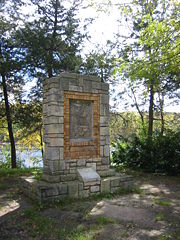
St. Croix Boom Site
Encyclopedia
The St. Croix Boom Site is a National Historic Landmark
located on the St. Croix River
upstream of Stillwater, Minnesota
. The site was founded by Stillwater lumber barons, including Isaac Staples
, in 1856 after the demise of the original St. Croix Boom Company, which had operated a log boom
further upstream near Marine on St. Croix, Minnesota
. Staples and others purchased the Boom Company and moved the site downstream.
Timber harvested upstream was branded with the logo of the company that had harvested it. The logs were floated down to the boom, where they were sorted by the brands and delivered to the sawmills in Stillwater. The boom company collected a fee of 40 cents per thousand board feet (17 cent/m³) delivered.
The St. Croix Boom was a very profitable enterprise. In addition to a generous fee written into the company's charter and an efficient design that allowed it to be run by a small crew during slow periods, the sheer amount of timber that was being harvested made for high profits. During the 1870s, logs were frequently backed up for 15 miles (25 km) above the boom during mid-summer.
The boom site was operated until 1914, by which time all the surrounding river bank area were denuded of trees. The site was forgotten and was rediscovered in 1975 by a National Park Service survey to identify historic sites along the St. Croix River, in preparation for its designation as a National Scenic Waterway. By 1975, the area had been reforested.
The Boom Site has been a popular destination on the St. Croix. There is a wayside rest with restrooms and a parking area on top of the bluff with stairs down to a beach at the site. Its location at the head of Lake St. Croix, the broad, slow area of the river that stretches from Stillwater to Prescott, Wisconsin
, where the St. Croix joins the Mississippi River
, is undeveloped and features many islands and tall sandstone bluffs on either side of the river.
 A plaque on a historic marker near the site once read, "Center of log and lumbering activities in this region for over half a century prior to 1914. Here millions of logs from the upper St. Croix and tributaries were halted, sorted, and rafted, later to be sawed into lumber and timber products. More logs were handled here than at any similar place in this section. 1940." As shown in the picture, the marker has since been vandalized. In October 2005, the Boom Site wayside rest and parking areas were closed as a result of budget cuts by the Minnesota Department of Transportation
A plaque on a historic marker near the site once read, "Center of log and lumbering activities in this region for over half a century prior to 1914. Here millions of logs from the upper St. Croix and tributaries were halted, sorted, and rafted, later to be sawed into lumber and timber products. More logs were handled here than at any similar place in this section. 1940." As shown in the picture, the marker has since been vandalized. In October 2005, the Boom Site wayside rest and parking areas were closed as a result of budget cuts by the Minnesota Department of Transportation
. These factors have put the site on the "watch" list within the National Historic Landmarks program.
National Historic Landmark
A National Historic Landmark is a building, site, structure, object, or district, that is officially recognized by the United States government for its historical significance...
located on the St. Croix River
St. Croix River (Wisconsin-Minnesota)
The St. Croix River is a tributary of the Mississippi River, approximately long, in the U.S. states of Wisconsin and Minnesota. The lower of the river form the border between Wisconsin and Minnesota. The river is a National Scenic Riverway under the protection of the National Park Service. A...
upstream of Stillwater, Minnesota
Stillwater, Minnesota
As of the census of 2000, there were 15,143 people, 5,797 households, and 4,115 families residing in the city. The population density was 2,340.0 people per square mile . There were 5,926 housing units at an average density of 915.7 per square mile...
. The site was founded by Stillwater lumber barons, including Isaac Staples
Isaac Staples
Isaac Staples was a powerful lumber baron in the St. Croix River Valley during the logging boom of the late 19th century.Aside from his massive holdings and operations in timber, sawmills and the St...
, in 1856 after the demise of the original St. Croix Boom Company, which had operated a log boom
Log boom
A log boom is a barrier placed in a river, designed to collect and or contain floating logs timbered from nearby forests sometimes called a fence or bag. The term is also used as a place where logs were collected into booms, as at the mouth of a river...
further upstream near Marine on St. Croix, Minnesota
Marine on St. Croix, Minnesota
Marine on St. Croix is a city in Washington County, Minnesota, United States. The population was 689 at the 2010 census.-Geography:According to the United States Census Bureau, the city has a total area of , of which, of it is land and of it is water. Minnesota State Highway 95 serves as a main...
. Staples and others purchased the Boom Company and moved the site downstream.
Timber harvested upstream was branded with the logo of the company that had harvested it. The logs were floated down to the boom, where they were sorted by the brands and delivered to the sawmills in Stillwater. The boom company collected a fee of 40 cents per thousand board feet (17 cent/m³) delivered.
The St. Croix Boom was a very profitable enterprise. In addition to a generous fee written into the company's charter and an efficient design that allowed it to be run by a small crew during slow periods, the sheer amount of timber that was being harvested made for high profits. During the 1870s, logs were frequently backed up for 15 miles (25 km) above the boom during mid-summer.
The boom site was operated until 1914, by which time all the surrounding river bank area were denuded of trees. The site was forgotten and was rediscovered in 1975 by a National Park Service survey to identify historic sites along the St. Croix River, in preparation for its designation as a National Scenic Waterway. By 1975, the area had been reforested.
The Boom Site has been a popular destination on the St. Croix. There is a wayside rest with restrooms and a parking area on top of the bluff with stairs down to a beach at the site. Its location at the head of Lake St. Croix, the broad, slow area of the river that stretches from Stillwater to Prescott, Wisconsin
Prescott, Wisconsin
Prescott is a city in Pierce County, Wisconsin at the confluence of the St. Croix River and Mississippi River. The population was 4,258 at the 2010 census, making it the second-largest city in the county after River Falls, and the largest entirely within Pierce County.Prescott was home to the...
, where the St. Croix joins the Mississippi River
Mississippi River
The Mississippi River is the largest river system in North America. Flowing entirely in the United States, this river rises in western Minnesota and meanders slowly southwards for to the Mississippi River Delta at the Gulf of Mexico. With its many tributaries, the Mississippi's watershed drains...
, is undeveloped and features many islands and tall sandstone bluffs on either side of the river.

Minnesota Department of Transportation
The Minnesota Department of Transportation oversees transportation by land, water, and air in the U.S. state of Minnesota. The cabinet-level agency is responsible for maintaining the state's trunk highway system The Minnesota Department of Transportation (Mn/DOT, pronounced "min-dot") oversees...
. These factors have put the site on the "watch" list within the National Historic Landmarks program.
External links
- https://fowcssl.webaloo.com/stcroix_boomsite.aspx

